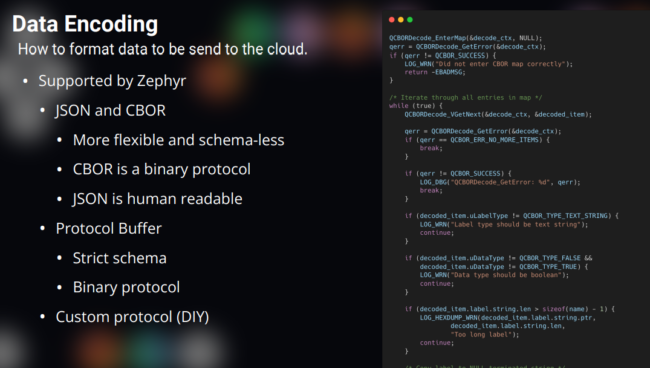ZDS: End-to-end IoT Development with Zephyr by Alvaro Viebrantz
Founding Engineer of Golioth, Alvaro Viebrantz went to the Zephyr Developer Summit…and said the hardware isn’t the only part of an IoT system that matters. That’s bold! This was a room full of hardware and firmware designers!
In reality, this talk is about everything else you should consider when building a device using the Zephyr Real Time Operating System (RTOS). Alvaro goes through the many layers and considerations when architecting large scale Internet of Things (IoT) deployment, from the servers, to the apps, to how devices are communicating back to the cloud, and yes, all the way down to the code put onto the end device.
Top Down Design
Most IoT users first experience a device not from holding the hardware in their hand and seeing it do some particular action. Instead, users rely on things like Dashboards and Applications. The physical device is often hidden from the end user, at least inside an enclosure, and sometimes entirely (as in the case of something like a home monitor in your attic).
It’s important to start by mapping your data model, often before you even start your first schematic. What will your device do? How will it be accessed hierarchically? What other elements are part of the system or will be in the future?
Also important, you should follow the ownership of both the physical device and that device’s output data all the way up the chain back to the user. How will a user claim a device belongs to them? How will you organize the various levels of permission required? What kind of questions will your users seek to answer with the end device or with the entire fleet? (ie. “Do any vehicles in the fleet have low battery?”)
Who is in charge here?
After you have considered how you will configure your database and what the end user will see when they are interacting with data, you should move on to access levels and which parts of the system are accessible by different individuals. This may include access to the end application, but should also include access control to the configuration components of the system. You don’t want your end users to be able to access your device management console, even if they are the ultimate owner of the device. Instead, you will want to provision the devices so you know the unique identifiers of the end-device, and then assign that and the access level to the user.
Additional layers required for a realistic IoT deployment
As you continue to move “down the stack” from Applications all the way to the hardware, there is still a good chunk of Cloud in between. You’ll want to make sure you at least understand all of the elements you’ll likely want in your design, including:
- Device management
- Device state and configuration
- Bidirectional command and control
- Time-series data and events
Connecting to the network
We’re almost down at the device itself, but the connection to the network is another key consideration before we get there. Not just the method of connection (which ultimately relies on the hardware), but also the protocol and the pathways of each packet coming back. In Golioth’s case, we default to CoAP, which is a lower overhead, UDP based protocol. All of our device SDKs include support to make it easy to talk to CoAP endpoints on the Golioth servers. As Alvaro mentioned in his talk, and as our SDKs also feature, encoding can help to shrink messages even further, using things like protobuf, JSON, and CBOR.
Finally the hardware
By this point in the room, we were squarely back into the realm of expertise of Zephyr developers, though many now had a greater appreciation of all the other things required for IoT systems. Alvaro mentioned how some of the interaction of the connectivity on-device in Zephyr could affect your decision making further up the stack. This talk to a packed room showed developers how to plot out a successful IoT deployment beyond the limits of the hardware, and to think about IoT systems from the hardware, all the way up to the end user.





Start the discussion at forum.golioth.io